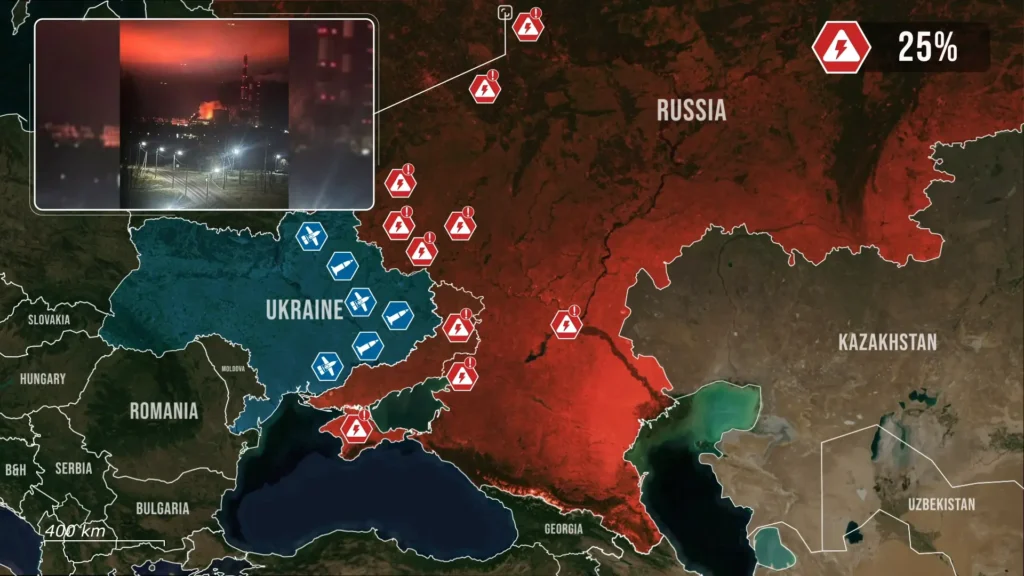Today, the biggest news comes from the Russian Federation.
Here, for the first time, Ukraine has launched a coordinated missile offensive against Russia's power network, demolishing major thermal power plants.
After months of drone warfare, Kyiv has escalated to precision missile strikes, a shift that has left entire cities without power, heat, or water, and exposed the fragility of Russia's grid in a way drones never could.

Three missiles devastate Voronezh thermal power plant
The most significant hit came in Voronezh, where three missiles struck the city's thermal power plant. Two missiles impacted the newly built boiler block, shredding steam generators and turbines connected to LM-6000 gas modules, and another missile pierced the roof of the turbine wall. Within minutes, power and heating dropped across several districts, leaving over a thousand industrial users, including the critical Voronezh chemical plant, offline.
The plant's new energy block, finished in 2019, had been among the most modern in Russia's regional network. Its destruction signals that Ukraine can now disable newly built, high-efficiency targets previously considered too hardened for drones to damage effectively.

Orel strike destroys sections of thermal power plant outright
In Orel, the attack was equally devastating, and as residents reported no buzzing typical of drones, only deep, sustained explosions that lit up the skyline, it became clear that Ukrainians carried out the strike with cruise missiles.
The Orel thermal power plant had already been damaged by drones earlier this month, but this time several sections were destroyed outright. Analysts say it powered roughly 40 percent of the region's electricity and up to 65 percent of Orel's central heating. The strike caused widespread outages and may have permanently disabled one of the plant's turbine halls.
Together, the two operations mark Ukraine's first deliberate campaign using long-range precision missiles against Russia's core energy system, a capability that had been withheld until now.

Why missiles change the strategic calculus
This shift marks a turning point, as missiles change both scale and tempo, and unlike drones, which rely on swarming and attrition, missiles can deliver concentrated kinetic power with pinpoint accuracy, overwhelming localized air defenses before they can adapt. They also travel faster and hit harder, often detonating with enough force to destroy reinforced infrastructure that drones can only set on fire.


While drones have proven cost-effective, missiles offer immediacy, as one strike can erase an entire generating unit rather than disable a single transformer. In this sense, Ukraine's use of missiles signals confidence in its ability to sustain a higher-intensity strategic campaign, one that directly undermines Russia's war economy by freezing its energy backbone.
Trending Now


Drone strikes continue to compound Russia's grid crisis
Yet even as Kyiv transitions to missiles, the continued effectiveness of its drone operations shows how bad the situation has already become for Russia. If missiles can now take out plants in Voronzeh and Orel, consider what drones alone have already achieved, with repeated blackouts in Belgorod, Bryansk, and Kursk, and fires at high-voltage substations in Vladimir and Volgograd, and power cuts across Russian-controlled Luhansk and Crimea.

In Belgorod, a strike on the Luch thermal power plant left 20,000 residents without power, plunging the city into darkness. In Vladimir, the massive 750 kilovolt Vladimirskaya substation, one of Russia's most powerful, was hit again just weeks after repairs, showing how Ukraine can repeatedly disable high-voltage nodes faster than Russia can restore them.

The pattern continued across the country, as drone strikes ignited the T-25 substation in Taganrog, cutting power to multiple districts, while explosions in Dzhankoi hit transmission links used by Russian military units. In Volgorechensk, Ukrainian drones struck the Kostroma GRES, Russia's third most powerful thermal plant, forcing emergency shutdowns.
In Luhansk, FP-1 kamikaze drones destroyed six substations in one night, leaving Russian army positions without power. Each of these adds pressure to a grid that no longer has the redundancy to reroute electricity effectively.
A two-layer strategy: missiles for destruction, drones for disruption
Within weeks, Ukraine has fused missiles and drones into a two-layer strategy, missiles for destruction, drones for disruption. Energy output is collapsing not from one catastrophic event, but from hundreds of overlapping failures. Analysts estimate that Ukraine's strikes have crippled a quarter of Russia's generating capacity.

Overall, Ukraine's decision to unleash missiles against Russia's power network marks a decisive escalation, and one that Moscow may struggle to answer. The strikes on Voronezh and Orel show that even newly built plants are vulnerable, while ongoing drone raids ensure constant grid instability.
Russia can patch the holes, but not fast enough to stop new ones. The war for energy dominance has entered a new phase, one where Ukraine no longer just disrupts Russia's power, but systematically dismantles it.
In our regular frontline report, we pair up with the military blogger Reporting from Ukraine to keep you informed about what is happening on the battlefield in the Russo-Ukrainian war.





